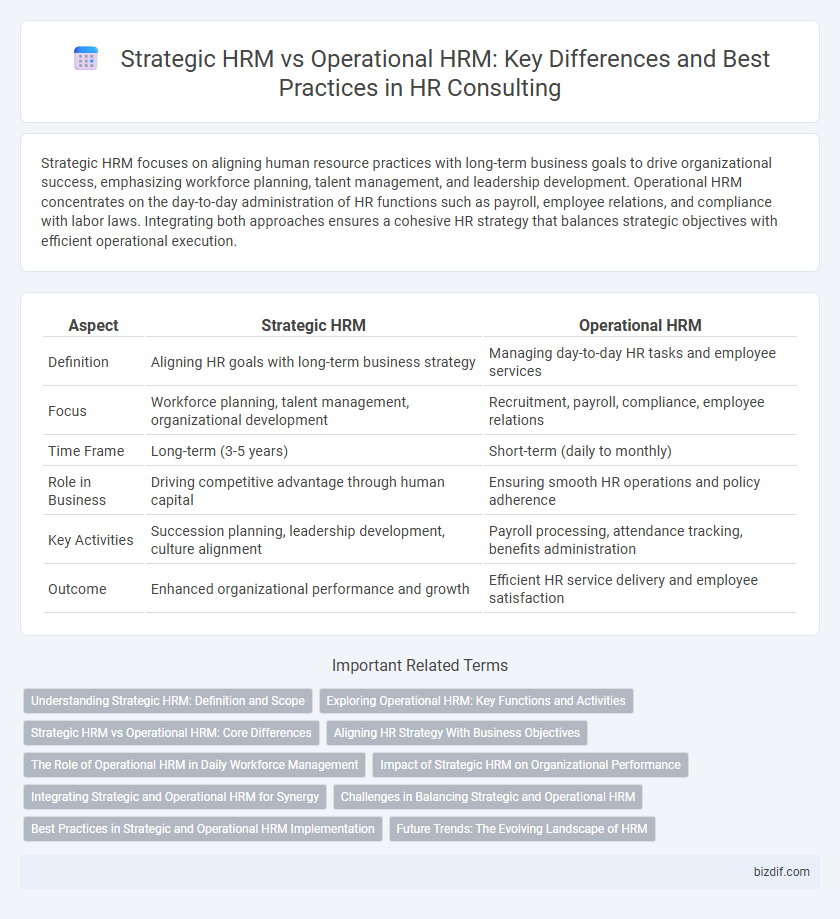Strategic HRM focuses on aligning human resource practices with long-term business goals to drive organizational success, emphasizing workforce planning, talent management, and leadership development. Operational HRM concentrates on the day-to-day administration of HR functions such as payroll, employee relations, and compliance with labor laws. Integrating both approaches ensures a cohesive HR strategy that balances strategic objectives with efficient operational execution.
Table of Comparison
| Aspect | Strategic HRM | Operational HRM |
|---|---|---|
| Definition | Aligning HR goals with long-term business strategy | Managing day-to-day HR tasks and employee services |
| Focus | Workforce planning, talent management, organizational development | Recruitment, payroll, compliance, employee relations |
| Time Frame | Long-term (3-5 years) | Short-term (daily to monthly) |
| Role in Business | Driving competitive advantage through human capital | Ensuring smooth HR operations and policy adherence |
| Key Activities | Succession planning, leadership development, culture alignment | Payroll processing, attendance tracking, benefits administration |
| Outcome | Enhanced organizational performance and growth | Efficient HR service delivery and employee satisfaction |
Understanding Strategic HRM: Definition and Scope
Strategic HRM involves aligning human resource policies and practices with long-term organizational goals to enhance competitive advantage. It encompasses workforce planning, talent management, and organizational development aimed at driving business strategy. This approach contrasts with Operational HRM, which focuses on day-to-day HR functions such as payroll, compliance, and employee relations.
Exploring Operational HRM: Key Functions and Activities
Operational HRM centers on the execution of daily human resource tasks such as recruitment, payroll processing, employee relations, and compliance with labor laws. These activities ensure the smooth functioning of organizational processes and support strategic goals by maintaining workforce stability and productivity. Key functions include managing employee records, administering benefits, facilitating training programs, and handling performance appraisals.
Strategic HRM vs Operational HRM: Core Differences
Strategic HRM aligns human resource policies with long-term business goals, emphasizing workforce planning, talent management, and organizational development to drive competitive advantage. Operational HRM focuses on day-to-day HR functions such as payroll administration, employee relations, and compliance with labor laws to ensure smooth organizational operations. The core difference lies in Strategic HRM's proactive, future-oriented approach versus Operational HRM's reactive, task-oriented execution.
Aligning HR Strategy With Business Objectives
Strategic HRM involves designing HR policies that directly support long-term business goals, ensuring workforce capabilities drive competitive advantage. Operational HRM focuses on executing daily HR tasks like recruitment, training, and compliance, maintaining organizational efficiency. Aligning HR strategy with business objectives maximizes employee performance impact, fostering sustainable growth and organizational agility.
The Role of Operational HRM in Daily Workforce Management
Operational HRM plays a critical role in daily workforce management by overseeing employee relations, process implementation, and compliance with labor laws, ensuring smooth organizational functioning. This function is responsible for payroll administration, attendance tracking, and addressing employee grievances to maintain workforce stability and productivity. Effective operational HRM supports strategic HRM by translating long-term goals into actionable daily practices that improve operational efficiency.
Impact of Strategic HRM on Organizational Performance
Strategic HRM aligns human resource policies with long-term business goals, directly enhancing organizational performance through improved employee productivity, innovation, and competitive advantage. Emphasizing talent acquisition, leadership development, and organizational culture, Strategic HRM drives sustainable growth and adaptability in dynamic markets. In contrast, Operational HRM focuses on routine administrative tasks, which, while essential, have a limited impact on strategic outcomes.
Integrating Strategic and Operational HRM for Synergy
Integrating strategic and operational HRM drives organizational effectiveness by aligning long-term goals with day-to-day HR practices, ensuring workforce capabilities support business strategy. Strategic HRM focuses on talent acquisition, leadership development, and succession planning, while operational HRM handles recruitment, training, and employee relations. Synergizing these functions enhances agility, promotes employee engagement, and maximizes human capital ROI through cohesive policy implementation and performance management.
Challenges in Balancing Strategic and Operational HRM
Balancing strategic and operational HRM requires navigating complex challenges such as aligning long-term organizational goals with immediate workforce needs and managing resource constraints that impact both strategic initiatives and day-to-day HR functions. Organizations often struggle to integrate data-driven decision-making tools in operational HR processes while maintaining a visionary approach to talent management and organizational development. Effective communication between HR leaders and line managers is critical to overcome silos and ensure that strategic priorities translate into actionable operational practices.
Best Practices in Strategic and Operational HRM Implementation
Effective implementation of Strategic HRM involves aligning human resource practices with long-term organizational goals, utilizing data-driven workforce planning, talent management, and leadership development to gain competitive advantage. Operational HRM best practices emphasize efficient execution of daily HR tasks such as recruitment, payroll, compliance, and employee relations, ensuring smooth organizational functioning and employee satisfaction. Integrating technology like HR analytics and automated systems enhances both strategic decision-making and operational efficiency, driving overall organizational performance.
Future Trends: The Evolving Landscape of HRM
Strategic HRM is increasingly shaped by AI-driven analytics and workforce automation to predict talent needs and align human capital with long-term business goals. Operational HRM focuses on digitizing employee engagement, payroll, and compliance processes to enhance efficiency and accuracy in daily HR functions. Emerging trends emphasize integrating continuous learning platforms and diversity metrics to future-proof workforce management and foster inclusive cultures.
Strategic HRM vs Operational HRM Infographic

 bizdif.com
bizdif.com